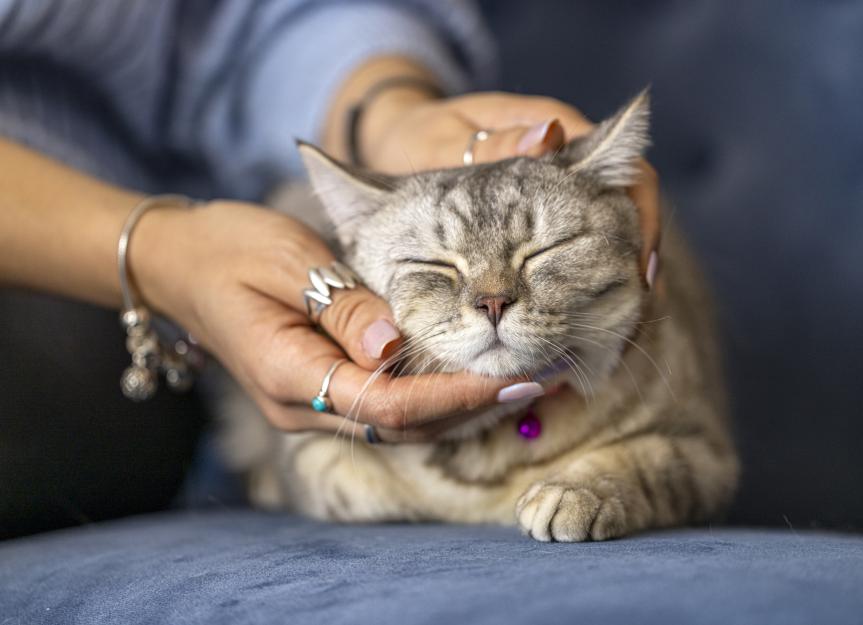
Massage therapy is widely used in humans to relieve stress and muscle tension, but did you know that cats can benefit from a massage too?
Key Takeaways
- A cat massage can relieve stress, improve circulation, and strengthen the bond between you and your cat.
- Always start with gentle strokes in a calm, quiet environment, and stop if your cat shows signs of discomfort.
- Avoid massaging cats with certain health conditions like heart problems, open wounds, or infections—check with your vet first.
- Products like calming sprays, paw creams, or massage serums can enhance your cat’s massage experience.
What Is a Cat Massage?
A massage for your cat is a technique that involves using the hands to work the soft tissues of the body (skin, muscle, and connective tissue) in long strokes or circular movements and moderate pressure. This helps to maintain or restore normal body function in specific areas.
You can massage your cat on the head, neck, back, legs, and paws.
A cat massage can be a fun addition to regular petting sessions, helping you form a stronger bond with your cat.
Still, it’s important to know how to massage your cat properly to prevent injury and make the experience enjoyable.
Do Cats Like Massages?
While it’s possible to take your cat to a pet massage therapist, it is relatively easy to do basic massage techniques at home.
Home massages can be helpful for your cat because you can control the volume and lighting in the environment, and they will be more likely to enjoy the experience with a familiar person and familiar smells around them.
However, a massage may not be for every cat. If your cat is in pain, is naturally very fearful, or is new to your home and not yet comfortable with you, it may be challenging to massage them effectively. Hence, it’s best to understand your cat’s personality before attempting to massage them.
You should also avoid massaging cats with heart conditions, open wounds, or acute infections or inflammation, and for some cancer patients.
Massage can sometimes worsen their symptoms, or they may need precise massage techniques done by a trained professional. It’s best to check with your vet first.
What Are the Benefits of Massaging Your Cat?
Research shows that massage can lead to stress and anxiety relief, strengthened connective tissue, decreased muscle tension, reduced swelling, improved circulation to the tissues, pain relief, and even enhanced quality of your cat’s sleep.
Massage can also be a way to bond with your cat, in addition to petting and cuddling sessions.
-
Allow your cat to stand, sit, or lie down for their massage, whatever is most natural for them and whatever they will tolerate the most.
-
Start with gentle pressure, moving in the direction of your cat’s fur along their chin, cheeks, neck, and back. Increase the pressure to moderate if your cat appears comfortable and relaxed.
-
If your cat is tolerant of a massage in these areas and enjoys being petted in other parts of their body, you can move on to their legs and paws, and possibly their belly if they typically enjoy being petted there.
-
Continue for a few minutes or up to 15 minutes per session, as long as your cat remains comfortable and shows no signs of stress
-
You may only be able to massage your cat for a few minutes at a time, or they may not enjoy massage at all, and that is OK.
-
If your cat shows signs of sudden aggression at any point, such as getting up, puffing up their fur, flattening their ears, hissing, or attempting to scratch or bite, it’s best to stop the massage right away.
To enhance the massage experience, you can apply a calming spray such as Feliway to a blanket, mat, or cat bed that your cat may rest on during the massage to improve feelings of relaxation.
If your cat enjoys a paw massage, you can add a paw ointment such as The Blissful Dog Cat Paw Cream to moisturize and condition their skin at the same time.
Cat Massage FAQs
Where do cats like to be massaged?
Cats generally enjoy being massaged in areas where they like to be petted, such as the cheeks, chin, neck, and back.
Some cats who are easygoing or accustomed to handling from an early age may enjoy massage in other areas of their body, such as the top of their head, legs, or even their belly.
However, the belly is often a sensitive and vulnerable area for cats that pet parents should avoid. Pay attention to what your cat likes and doesn’t like when giving them a massage.
Is it good to massage your cat?
Yes. If your cat accepts the massage, it can be a great way to bond with them, relieve their pain and muscle tension, and encourage them to relax. But if your cat has a health condition or an open wound, it may worsen symptoms.
It’s best to consult with your veterinarian to confirm whether it’s safe for you to massage your cat at home.
How do you massage a cat?
To massage a cat, ensure you are in a quiet environment, and the cat is in a comfortable position. Use gentle hand movements along their face, neck, and back to gradually relax, increasing pressure as they become more comfortable and accept the massage.
You can incorporate gentle circular motions as well as long strokes in the direction of your cat’s fur. Stress body language signals can include flattened ears, puffed-up fur, hissing or yowling, or trying to get up and walk away.



